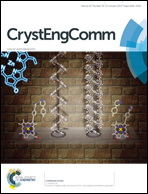Post-synthetic pore-space expansion in a di-tagged metal–organic framework†
Abstract
A rarely observed example of post-synthetically increasing pore space, while retaining the chemical functionality of the original metal–organic framework is reported. Conventional solvothermal heating in air was used to effect an efficient post-synthetic rearrangement of a bisallyloxy-tagged zinc metal–organic framework. This leads to the pore-space expanded MOF displaying a higher surface area yet lower affinity for CO2 sorption compared to the original MOF.


 Please wait while we load your content...
Please wait while we load your content...